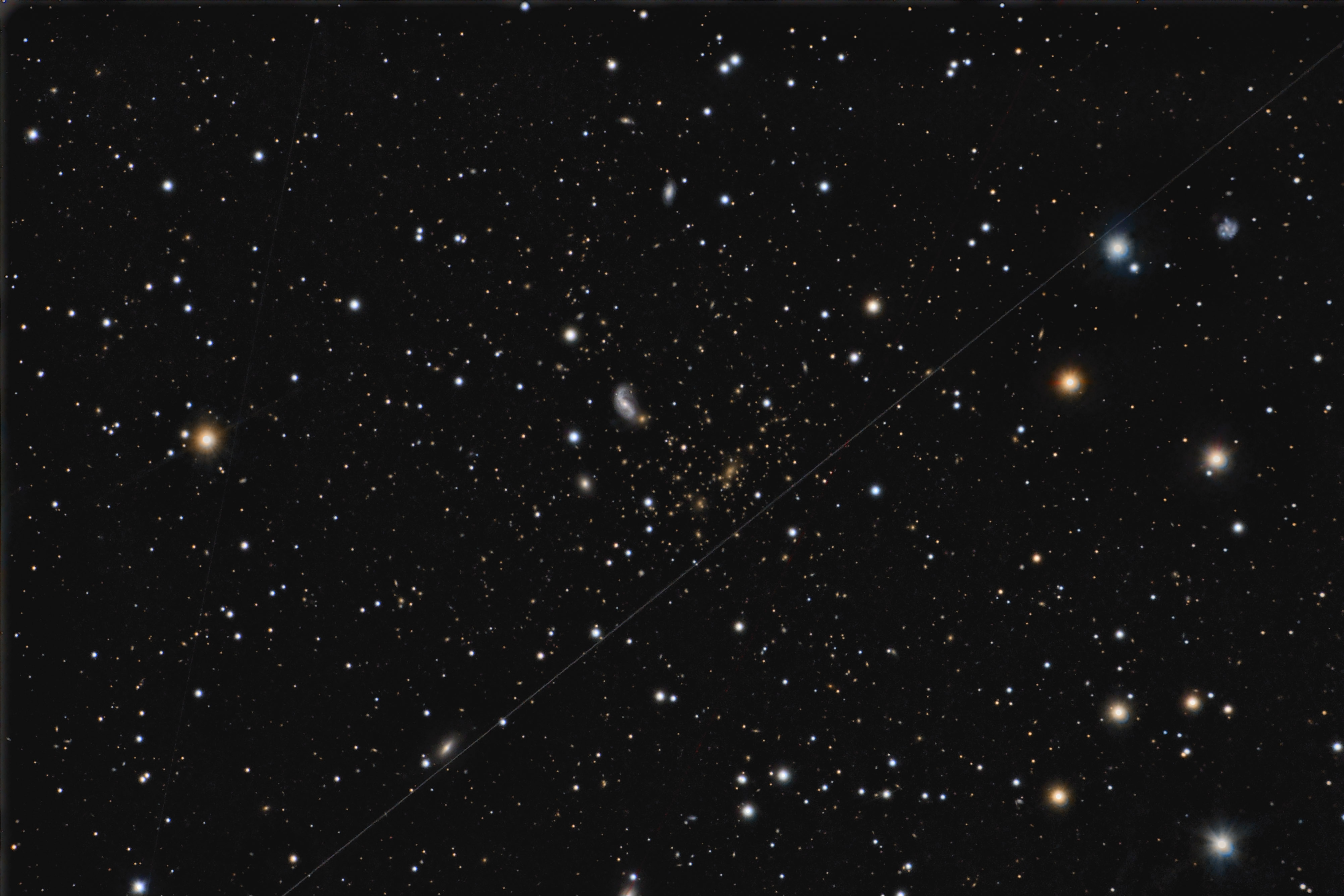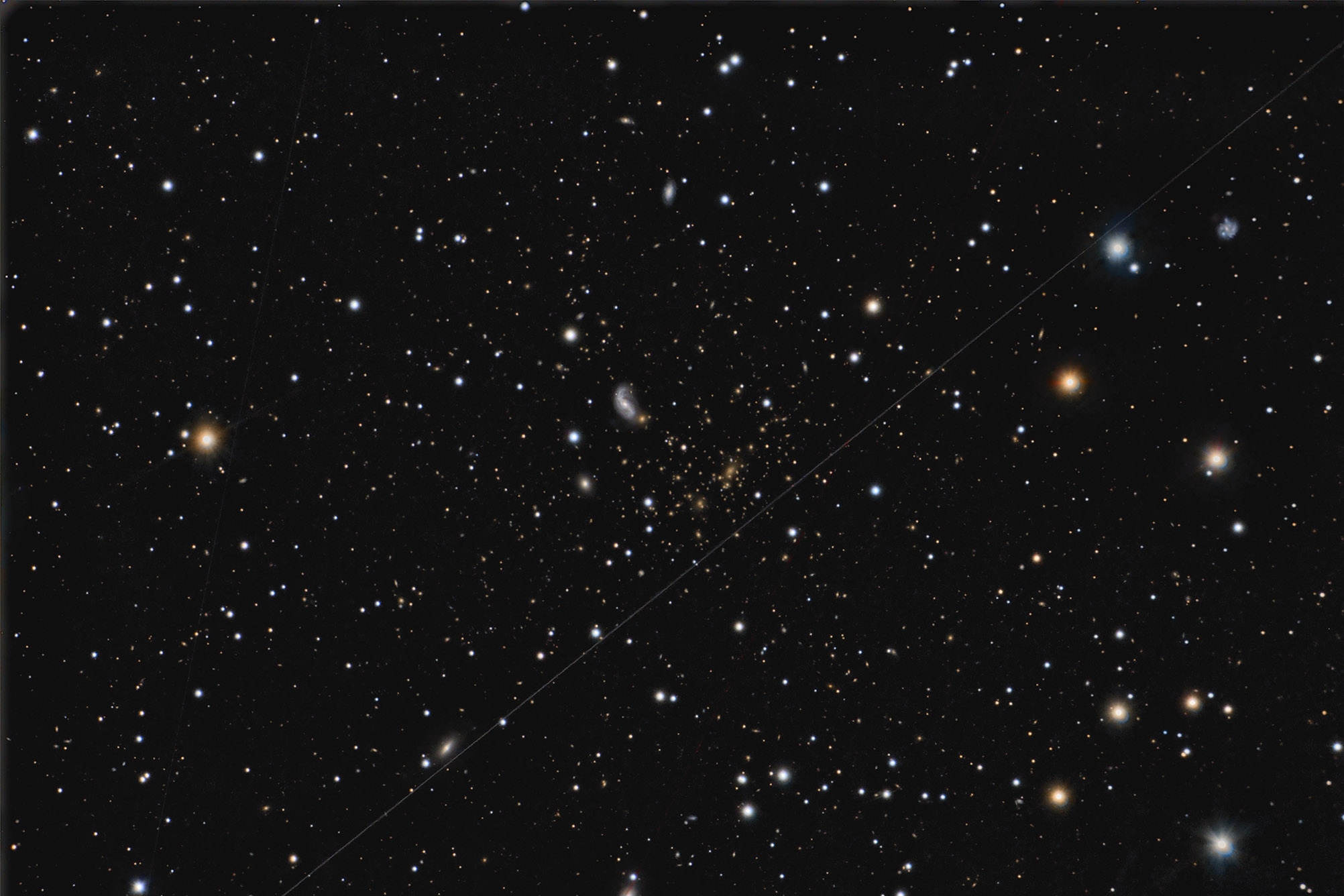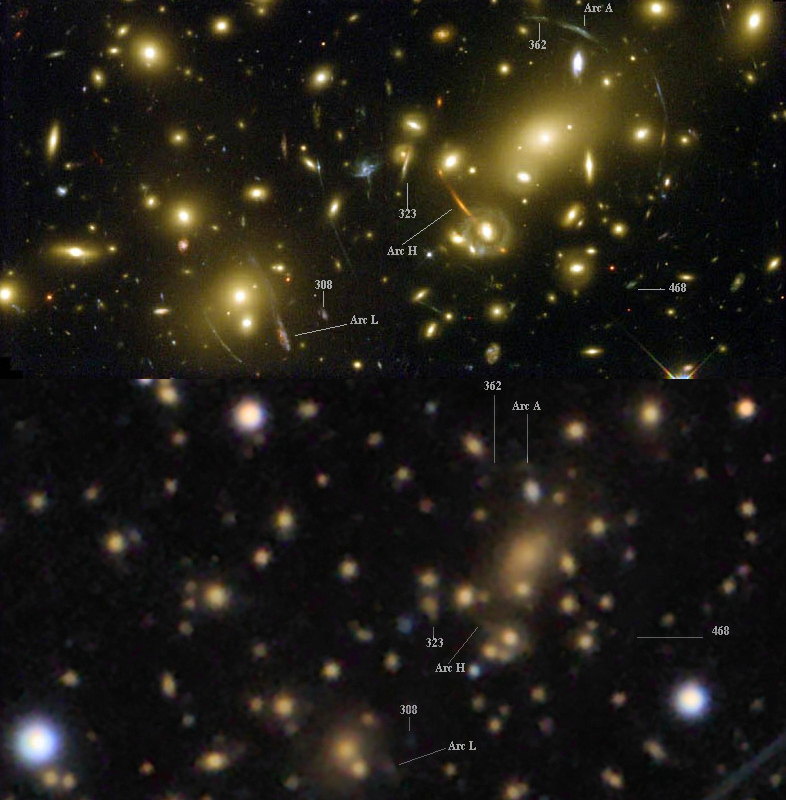Object name: ABELL2218Designation(s): ABELL2218, ABELL 2218 is a galaxy cluster in Draco over 2 billion light-years distant. The reason I took it is that it has some rather "bright" gravitational arcs of far more distant galaxies behind the cluster that I thought were within reach. To the northeast of the cluster is an interesting Sa spiral galaxy PGC 058586 at only 328 million light-years. It has an orange companion to the south end and a plume stretching from that companion to the east. I thought these an interacting pair but NED puts the "companion" at the same distance as the cluster making it a cluster member some 7 times further away. The source of the plume remains a mystery it seems.
The first image of the cluster is at my usual image scale of 1" per pixel. I did this one back in 2008 when I wasn't taking satellites out of my image as I do now. Two are visible in the image. At this scale, the arcs are difficult to see. The second image is at the image scale of 0.5" per pixel. Now you can start to see the arcs I picked up. The third image is annotated and enlarged to 0.25" per pixel. Beyond my system's resolution but does make pointing out the arcs easier. I've also included the HST image at the same scale for comparison.
Arc A, galaxy 362 and galaxy 468 are all the SAME galaxy. It is located some 10.7 BILLION light years from us and 8.7 billion light years beyond the lensing cluster Abell 2218. Arc A has a magnitude of 22.35. Arc 362 is listed by NED as magnitude 24.52 while 468 is magnitude 23.74 Image 468 is virtually undistorted but even Hubble can't see much detail in it. Arc A, once deconvolved shows more detail. This is a very interesting galaxy. You can read more about it at:
http://arxiv.org/PS_cache/astro-ph/pdf/9802/9802230v1.pdf
This is a PDF file you need a PDF reader to view it.
The idea I could see things this faint is far beyond my expectations when I designed the observatory. Note the article says the true magnitude of the galaxy is 14.5 times fainter than this. So I'm only seeing it thanks to one of the universe's largest telescopes, one that is millions of light years across but with a rather imperfect lens.
Arc H is rather bright in Hubble's image but my CCD is rather insensitive to its red color making it harder for me to pick up. It is listed as being 6.1 billion light years from us, 4 beyond the imaging cluster and is listed at magnitude 24.4 which seems low to me.
Arc 323 is listed at 22.2 magnitude and is only 4.1 million light years away so it is about from the lensing cluster as we are from the cluster. It may be the brightest arc but it is rather lost in the galaxy making it hard to see in my image.
Arc L is interesting in that it is two arcs if you look closely at the Hubble image. A blue arc and a rather small red blob near one end. It all merges together in my "low resolution" image. Anyway, the blue arc is a quasar that was located in just the right spot to be highly distorted into a blue arc by the lens yet the galaxy around it is nearly undistorted. Redshift data shows both to be at the same distance of 7.6 billion light years and the combination shines at magnitude 23.4.
The remaining object is galaxy 308. It too seems rather undistorted. It is magnitude 23.39 and is 5.6 billion light-years away. If you compare two images other lensed galaxies can be seen as well but I was unable to get much info on them so I'll stop here.
The Abell cluster is listed as being BM type II meaning its galaxies group around two major galaxies. The northwestern one seems to have a large halo about it from all the members it has devoured in the past. It is LEDA 140648 at about magnitude 17. Redshift puts it at 2.14 billion light-years which we can assume is a good estimate for the cluster's distance. NED shows a diameter of 20 arc minutes which seems about twice as large as it appears in my image though some of the faint fuzzies beyond its obvious edges may be members. There were too many for me to try and look up. The cluster is listed at richness class 4 which means that starting at the magnitude of the 3rd brightest member and going 2 magnitudes fainter there are 200 to 299 galaxies. It makes no attempt to count the galaxies fainter than this of which there are many. Clusters with more than 299 in this range are the highest class -- 5. This puts ABELL 2218 among one of the richest ABELL clusters. To go this faint I used 2 hours of luminance data rather than the 40 minutes used for most of my images.
14" LX200R @ f/10, L=6x20' RGB=2x20', STL-11000XM, Paramount ME Related Designation(s):1ES 1635+663, 1RXS J163553.7+661243, 1WGA J1635.9+6635, ABELL 2218, ABELL2218, EXSS 1635.7+6618, MCXC J1635.8+6612, NSC J163553+661240, PLCKESZ G097.73+38.11, PSZ1 G097.72+38.13, RBS 1596, RXC J1635.8+6612, ZwCl 1635.4+6618, | | 

